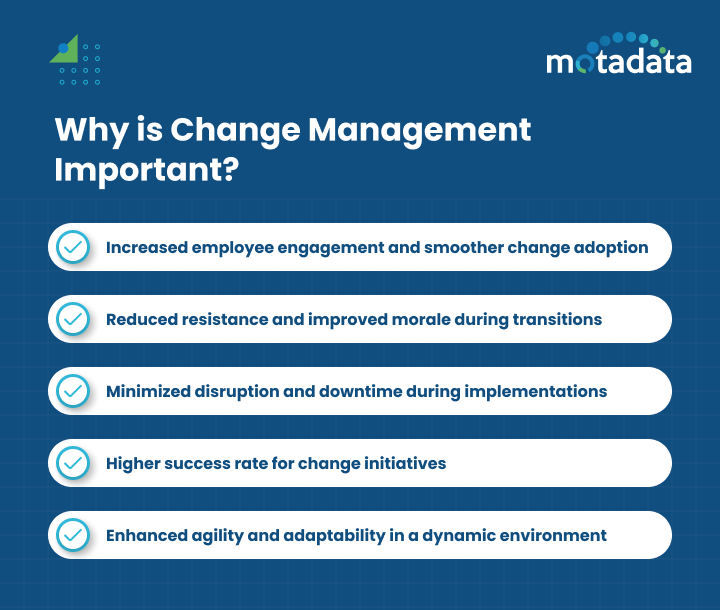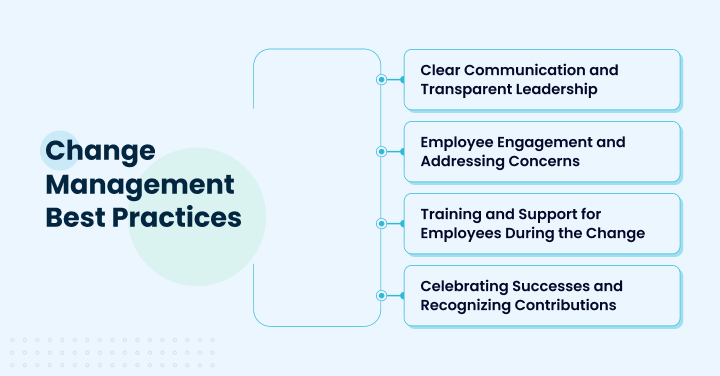Organizations must change to grow, develop, and stay ahead of competitors. 76% of customers expect businesses to grasp their unique needs and expectations.
Meanwhile, 66% are prepared to switch companies if they feel they’re being treated as just another number rather than an individual.
With change management, business leaders and project managers can improve organizational performance and achieve the desired future state.
Change management is a critical aspect that involves a structured approach to managing change efforts, i.e., adaptation of new technology or an organizational hierarchy shift. The process you follow will vary depending on the type of change you are making.
With successful change management, you can improve your financial status, operational efficiency, and profitability.
All you need to do is create a proper plan, clear goals, and use KPIs to monitor the overall status and progress.
In the evolving digital era, change management is highly critical within organizations.
Let us learn more about its intricacies, significance, and ways to implement it effectively within your organization.
What is Change Management?
IT Change Management is a structured approach that most businesses employ to manage modifications and changes within an IT system for better growth and development.
This approach involves adapting various processes, tools, and techniques to control change efforts and reduce risks and disruptions.
The main goal is to establish plans for bringing about change, managing it, and assisting individuals in adapting to it.
This discipline is crucial in the constantly evolving world of information technology, where updates, upgrades, and modifications are both normal and required.
How Change Management Works?
Successful change management occurs with the right implementation, planning, and monitoring.
Each project often faces unforeseen events during execution that lead to change.
Any major changes must be recorded and shared with the team for a project to stay aligned.
Similarly, there are more steps that one must take care of to ensure a structured approach to change.
Let us understand how a change management process works in detail.
Here are a few key steps that an IT team or individual must follow for a successful implementation of the process:
Identifying the need for change and defining goals
First, you must analyze the need for change and recognize its necessity. Market demand, new technology advancements, and the need for improvement in internal processes are a few factors that might be the main drivers of this change.
Hence, the type of change and the main cause behind its implementation must be identified.
Assessing the current state and potential impact
Once you are clear with the objectives, the second step is analyzing the current state of an organization with your desired future state.
Here, the team assesses the overall cost, behavior, and other aspects that may play a key role.
Also, it analyses the potential impact it may have on the change project.
Developing a communication and engagement strategy
Proper communication among team members is crucial for successfully implementing the process.
Hence, the team created a comprehensive communication plan covering all the change details.
Make sure to include members of different levels and roles in the process for support and quality input.
Implementing the change and providing support
Once the analysis and action plan are complete, the implementation phase is the next step.
Now, the project managers and team members ensure they have the right resources, training programs, and support from the helpdesk team to address issues that might arise during the transition period.
Monitoring progress and evaluating outcomes
Another aspect of the implementation process is continuous monitoring.
Another team tracks the change process continuously and ensures that the desired outcomes are achievable.
It checks whether the entire team can meet the desired goals and whether any other modifications are necessary.
Why is Change Management Important?
Here are some of the main reasons why change management plays a crucial role in organizational success:
1. Increased Employee Engagement and Smoother Change Adoption – Involving your employees in the change process helps in gaining their approval and support. The more an employee feels informed about the change, the higher the chances of convincing him.
Utilizing tools like a kudos platform can encourage open communication and recognition, making employees feel valued and more engaged during transitions. Adding branded employee gifts to your recognition strategy can further enhance morale and strengthen the connection between employees and the organization.
With their acceptance and implementation, everything might go smoothly.
2. Reduced Resistance and Improved Morale During Transitions – Fear or one’s belief that their job stability is in danger can frequently lead to resistance to change.
However, if your organization provides clear support and information, there are high chance that you will be able to overcome your team’s resistance and preserve their employee morale with effective change management.
3. Minimized Disruption and Downtime During Implementations – You can reduce the level of disruptions and downtime by adopting a structured change management procedure.
Further, it will ensure that your employees and team members will continue to operate efficiently during the implementation process.
4. Higher Success Rate for Change Initiatives – Your organization can better manage the incoming challenges with a structured approach. Thus, there is a high chance that you might achieve change objectives at a success rate.
5. Enhanced Agility and Adaptability in a Dynamic Environment – The ability to quickly adjust to change is a significant competitive advantage.
Through improved agility and adaptation, change management strengthens an organization’s resistance to both internal and external changes.
What are the Benefits of Change Management?
Some of the key benefits of change management include:
1. Increased Productivity:
When employees and team members are ready to adapt to the change and perform their tasks with minimal disruption, there are high chance that there will be a quick rise in your productivity level.
Further, the change management procedure will help maintain business continuity.
Lastly, using the best shared calendar app for business can further boost employee productivity by improving scheduling efficiency and facilitating better collaboration.
2. Improved Employee Morale:
Clear communication and participation of employees in the process helps lessen fear and anxiety among employees. This raises their morale and creates a happy workplace. Recognizing achievements with meaningful gestures, like plaques for recognition, can further boost employee motivation and foster a culture of appreciation.
3. Reduced Costs:
Time, money, and morale can all be lost on failed transformation projects.
By guaranteeing a systematic and planned approach, change management lowers the likelihood of failure and saves expenses related to unsuccessful change initiatives.
4. Enhanced Innovation:
Companies that successfully handle change are better able to innovate and maintain their competitive edge.
Innovation is sparked by the culture of constant adaptation and improvement that change management fosters.
Types of Change Management
The different models and approaches used to manage change initiatives include:
1. Lewin’s Change Management Model –
As per Lewin’s theory, restraining forces affect how people behave both individually and as a group, which ultimately determines whether or not change occurs.
Unfreeze, Change, and Refreeze are the three stages of this model that help highlight how important it is to plan for change, carry it out, and then establish the new condition as the accepted norm.
2. Kotter’s 8-Step Change Model –
Another popular change management framework enables businesses to effectively address digital innovation and organizational change by enlisting staff members to quickly accept and execute new procedures, technology, and other organizational modifications.
This model includes eight steps, i.e., creating a sense of urgency, forming a Guiding Coalition, strategic vision, communication, removing barriers, short-term wins, sustain acceleration, and change incorporation.
3. ADKAR Model –
Resisting organizational change can be minimized with the help of the outcome-oriented ADKAR Model of Change Management.
This model includes five essential phases, i.e., recognition of the need for change, willingness to engage in and support the change, understanding how to adapt, Possessing the necessary abilities and habits, as well as reinforcement to keep the change going.
Why Your Organization Needs Change Management
Without a robust change management strategy, your organization might face several significant challenges:
Decreased Productivity Due to Employee Resistance
Employees often resist change, negatively impacting their performance and overall productivity.
Implementing a structured change management system ensures that employees are well-trained and informed about the advantages of the change, reducing resistance and fostering a more adaptable workforce.
Increased Risk of Project Failure and Wasted Resources
Operating with outdated approaches and practices increases the risk of project failures, resulting in wasted human resources and missed opportunities. Adopting change management practices enhances project success rates and optimizes resource utilization.
Damage to Organizational Culture and Employee Trust
Poorly implemented change can disrupt the work culture and erode employee trust, leading to long-term organizational issues.
Effective change management helps maintain a positive work environment and strengthens trust between employees and the organization.
Change Management Best Practices
To improve organizational efficiency and productivity, consider these best practices in change management:
1. Clear Communication and Transparent Leadership
Ensure all stakeholders are fully aware of the impending changes, their rationale, and the necessary steps.
Open communication fosters collaboration, reduces resistance, and nurtures understanding. Transparent leadership builds trust and facilitates smoother transitions.
2. Employee Engagement and Addressing Concerns
Actively involve employees in the change process and address their concerns through open discussions and training programs.
Engaging employees and acknowledging their input builds trust and support, making the change process more effective.
3. Training and Support for Employees During the Change
Provide comprehensive training and resources to help employees adjust to the change.
This includes mentorship programs, help centers, and other support systems that facilitate a smoother transition.
4. Celebrating Successes and Recognizing Contributions
Acknowledge and celebrate employee achievements, no matter how small.
Recognizing individual contributions boosts morale and confidence, encouraging employees to invest more effort into achieving organizational goals.
Regularly analyze results and track the progress of change initiatives.
Use feedback tools to make necessary adjustments and continuously improve the change process, ensuring ongoing success and adaptability.
Trends that Will Impact Change Management Software in 2024
Emerging trends are shaping change management software’s future. In 2024, keep an eye out for these trends:
Artificial Intelligence (AI)
A lot of discussion has already occurred regarding artificial intelligence (AI) and generative AI, a subset of AI distinguished by its capacity to generate and modify information independently, depending on patterns and data inputs.
It is anticipated that these technologies will play a major role in driving innovation in the workplace.
AI can perform large-scale data analysis to produce forecasts and insights that assist businesses in making informed decisions and becoming a more data-centric organization.
Automation Of Routine Tasks
Routine task automation can expedite procedures and provide employees and team members more time to concentrate on more strategic aspects of change management.
Integration with Other Business Applications
Change management software that connects with other business systems provides a comprehensive view of the organization’s activities, making it easier to plan and carry out change efforts.
Using Change Management Software from Motadata
Motadata provides cutting-edge change management software to improve and simplify your change processes.
With this solution integrated into your organizational structure, change projects may be managed efficiently, guaranteeing smooth transitions and low disruptions.
Project managers and change leaders can use an organized strategy and match change initiatives with strategic goals.
Key Features and Benefits:
- Uses AI for data analysis
- Automates routine tasks for better efficiency
- Offers seamless integration
- It comes with an intuitive interface
- Eliminate Risks With ITIL-aligned Change Management Model
- Sends alerts for critical change events
- Track changes by running audit trails
Motadata equips your team to handle transformation projects with confidence and accuracy.
Its capabilities, such as documenting change requests and setting change controls, are specifically designed to meet the complicated needs of modern enterprises.
Using Motadata’s technology maximizes operational effectiveness and advances your company toward its objectives.
The software offers a holistic solution by leveraging emerging trends to address the problems that firms have throughout change initiatives.
Conclusion
This entire process is a structured approach that assists organizations in achieving long-term success and monitoring changing initiatives.
With the help of this approach, businesses can effectively manage change and improve operational efficiency and financial results.
There are several benefits to implementing a change management process in IT infrastructure.
Businesses may remain competitive in today’s market by implementing best practices and employing change management tools to adapt to changing conditions.
Motadata’s change management software is one of the popular tools in the market and comes with various key features and functionalities.
In short, to achieve sustainable growth and promote positive results, corporate leaders and change managers must master the important skill of change management.
FAQs
Implementing change management software guarantees transparency, monitors progress, and expedites communication. This program increases productivity and allows team members to adjust easily, resulting in effective implementations of the modification.
The 7 steps of change management include:
1. Identify the Need
2. Define your goals for the Initiative
3. Ensure Proper Communication and collaboration between teams, employees, and stakeholders
4. Empower broad-based action
5. Enable and Implement shift as per the plan of action
6. Monitor the shift and Celebrate success
7. Consolidate and Build a framework for Future Development
The five key elements that contribute to the effectiveness of change management include:
1. Strong leadership to create a vision for change and guide the efforts.
2. Clear and consistent communication highlighting the progress and impact of the change
3. Stakeholder Engagement and better decision-making
4. Providing the necessary training and development opportunities for employees to adopt the change
5. Measuring and determining the effectiveness of the initiatives









